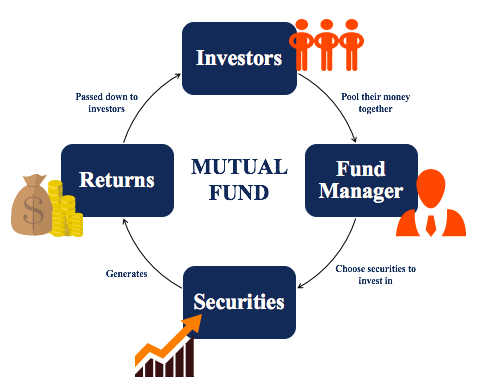This post may contain affiliate links. We may receive compensation when you click on links to those products at no additional cost to you. Read our full disclosure here.
We have all probably heard from somewhere or someone that investing to build wealth is important. However, trying to pick individual stocks, bonds, or other alternative investments can be very time-consuming and risky. Mutual funds and exchange-traded funds (ETFs) are tools that can offer an easier and safer way to invest in the market to achieve your goals through the power of diversification.
But what are mutual funds and ETFs exactly? How do they differ from each other? And which one should you choose? This comprehensive guide will aim to answer all your questions about mutual funds and ETFs.
Mutual Funds and ETFs 101
What are Mutual Funds?
Mutual funds are investment vehicles that pool money from multiple investors to purchase a diversified portfolio of stocks, bonds, or other securities. They are professionally managed by a fund manager who makes investment decisions on behalf of the investors.
Examples of mutual funds include the Vanguard 500 Index Fund (VFIAX), which tracks the S&P 500 index and invests in the 500 largest publicly traded U.S. companies, and the Fidelity Contrafund, which invests in companies with strong growth prospects. There are also mutual funds that focus on specific industries, regions, or investment strategies.
Types of Mutual Funds
There are two main types of mutual funds, open-end funds, and closed-end funds.
- Open-end funds continuously issue and redeem shares to meet investor demand, while closed-end funds issue a fixed number of shares that are traded on exchanges like stocks
- Open-end funds are priced based on the net asset value (NAV) of their underlying securities, while closed-end funds are priced based on supply and demand in the market
- Open-end funds generally have lower fees and minimum investment requirements than closed-end funds
- Closed-end funds may trade at a premium or discount to their NAV, which can create opportunities for investors to buy in at a discount or sell at a premium
- Closed-end funds can use leverage to potentially enhance returns, while open-end funds generally do not
- Closed-end funds trade on the exchange, but open-end funds trade only once a day
- Open-end mutual funds are way more common than closed-end funds
How Mutual Funds Are Created

Imagine you and a group of friends want to invest in the stock market, but you don’t have enough money to buy a diverse range of stocks. You can pool your money together and invest in a mutual fund instead.
A professional fund manager will use your money, along with the money of other investors, to purchase a diversified portfolio of stocks, bonds, or other securities.
Each investor in the mutual fund owns a share of the portfolio, which represents a portion of the overall holdings. The fund manager will then make investment decisions on behalf of the investors and will adjust the portfolio as needed based on the fund’s objective.
When the value of the portfolio increases, the value of each investor’s share will increase as well. Likewise, when the value of the portfolio decreases, the value of each investor’s share will decrease.
When an investor wants to buy or sell shares of the mutual fund, they do so through the investment company or a broker at the end-of-day net asset value (NAV).
Mutual Fund Fees
Fees associated with mutual funds include:
- Management fees, which are charged by the fund manager for managing the portfolio
- Sales charges, also known as loads, are fees paid by investors when they purchase or sell shares of the mutual fund
- There may also be fees associated with early redemptions or account maintenance
Mutual Fund Tax Treatment
Mutual funds are required by law to distribute the net capital gains and income earned by the fund to its shareholders at least annually. When the mutual fund manager buys and sells securities at the fund level, any gains (or losses) will be passed down to the investors.
Investors in mutual funds are responsible for paying taxes on the distributions they receive from the fund, whether they reinvest the distributions or take them in cash. This means that investors don’t really have control over the timing of distributions and taxes when investing in the mutual fund.
The tax treatment of mutual funds can be complex, as it depends on various factors such as the type of income earned by the fund and the investor’s tax bracket. It’s important to consult with a tax professional to understand the tax implications of investing in mutual funds.
How are Mutual Funds Traded?
Open-end mutual funds are traded through the fund company or a broker. Investors can purchase mutual funds through a variety of channels, including online brokers, financial advisors, or directly through the fund company. When an investor purchases shares of a mutual fund, the price is calculated based on the net asset value (NAV) of the fund, which is the value of the fund assets – fund liabilities divided by the number of shares outstanding.
Closed-end mutual funds are traded on an exchange. However, as the fund is “closed”, meaning they only issue a fixed amount of shares, liquidity may be limited if you want to buy shares but no one is selling, you’re out of luck.
Advantages of Mutual Funds
- Diversification: Mutual funds offer diversification by investing in a variety of stocks, bonds, or other securities. This reduces the risk of losses due to the poor performance of a single security. Learn more about diversification in our Diversification in Finance guide.
- Professional management: Mutual funds are managed by professional fund managers who have expertise in selecting and managing securities.
- Liquidity: Mutual funds are generally more liquid than individual securities. Investors can easily buy or sell their shares at the current market price.
- Accessibility: Mutual funds are available to individual investors with a wide range of investment amounts.
Disadvantages of Mutual Funds
- Fees: Mutual funds charge management fees, which can reduce the returns for investors. These fees are generally higher than the fees for ETFs. They may also charge redemption fees for selling shares before a certain period of time
- Taxes: Mutual funds can generate capital gains, which are taxable to investors. This can reduce the after-tax returns for investors
- Limited control: When you invest in a mutual fund, you are entrusting your money to a professional fund manager who makes investment decisions on behalf of all investors. This means you have limited control over the fund’s investments and may not agree with all of the manager’s decisions.
Index Funds – A Passive Mutual Fund
Index funds are a type of mutual fund that aims to replicate the performance of a specific market index, such as the S&P 500 or the Dow Jones Industrial Average.
Instead of a manager actively managing a portfolio of individual stocks or bonds, index funds invest in a basket of securities that matches the components and weighting of the underlying index. This approach can offer broad market exposure, low fees, and a passive investment strategy and is very similar to ETFs (aside from how it is traded) which we will learn in the next section.
What are ETFs?
Exchange Traded Funds (ETFs) are investment funds that track an underlying index or asset, such as the S&P 500 or gold. Some popular examples of ETFs include the SPY and QQQ. ETFs are similar to mutual funds, but the main difference is they trade on exchanges like individual stocks.
ETFs provide investors with a low-cost, transparent, and flexible way to invest in a diversified portfolio of securities or assets. ETFs are popular among long-term investors, as well as traders who use them for short-term tactical positions or hedging.
How ETFs are Created
While mutual funds are created by pooling investors’ money, ETF shares, on the other hand, are created through a process called “creation and redemption.” There are two main parties involved in this process:
- Sponsors who are the issuer and manager of the ETF.
- Authorized participants (APs) are financial institutions that have the ability to create or redeem shares of an ETF.
To create new ETF shares:
- APs buy the ETFs’ underlying securities (eg. shares of AAPL, AMZN, etc.)
- APs deliver the basket of securities to the ETF issuer
- The issuer issues new shares of the ETF in exchange for the basket of securities
- AP with its fresh set of ETF shares then sells the ETF on the stock market to people like you and I
To redeem ETF shares:
- AP buys the ETF shares on the market from people like you and I
- AP then delivers the ETF shares back to the issuer
- The issuer then gives the AP the basket of securities (eg. shares of AAPL, AMZN, etc.)
- The AP with the basket of securities will sell them back to the stock market
This creation and redemption process helps to keep the price of the ETF in line with its underlying securities in most cases. For example,
- If the ETF price goes too high compared to its underlying value, APs will step in and buy more underlying securities to get more ETFs
- AP with freshly created ETFs will then sell those ETFs back to the market as it is selling at a premium to what it is actually worth
- This selling of ETFs by the AP will drive the ETF price down until it is close to its NAV based on the concept of no-arbitrage.
Once created, ETF shares can be bought and sold on an exchange like individual stocks.
ETF Fees
ETFs generally have lower management fees than mutual funds, as well as lower transaction costs due to their passive management style. Passive management = less overhead expenses = more automation = lower fees.
The management fee of an ETF is typically expressed as an expense ratio, which is the percentage of assets under management that the sponsor charges to manage the fund. As of 2021, the average equity ETF expense ratio in the US is around 0.53%, according to data from ETF.com.
ETF Tax Treatment
ETFs are generally more tax-efficient than mutual funds because:
- The expenses and taxes of buying and selling between the sponsor and AP is fully borne by the AP. This is in contrast to mutual funds where capital gains and losses generated by the fund manager are passed down to investors
- ETFs typically have a low portfolio turnover as it is passively managed. This means less buying and selling of securities that can generate taxes
- As ETFs are traded like stocks, which means capital gains are only incurred if investors sell the ETF themselves. This means more flexibility for investors to time when they want a taxable event
How are ETFs traded?
ETFs trade on stock exchanges throughout the trading day, just like individual stocks. This allows investors to buy and sell ETF shares at any time during market hours at the prevailing market price. ETF shares are bought and sold through a brokerage account, just like individual stocks.
To purchase an ETF, investors need to open a brokerage account with a stockbroker or online brokerage platform like M1 Finance. Investors can choose from a wide range of ETFs that track various indices or assets, such as stocks, bonds, commodities, and currencies.
Once an investor has selected an ETF, they can place a buy order through their brokerage account. The shares of the ETF will then be credited to the investor’s account.
Advantages of ETFs
- Lower fees: ETFs generally have lower management fees than mutual funds.
- Transparency: ETFs provide transparency to investors by disclosing their holdings on a daily basis.
- Flexibility: ETFs can be bought and sold throughout the day, providing investors with more flexibility than mutual funds.
- Tax efficiency: ETFs are generally more tax-efficient than mutual funds due to their structure.
Disadvantages of ETFs
- Trading costs: ETFs may still have trading costs, such as commissions and bid-ask spreads, which can reduce returns for investors.
- Premiums and discounts: ETFs may trade at a premium or discount to their net asset value (NAV) based on supply and demand, which can reduce returns for investors.
Which one should you choose – Mutual Funds vs ETFs?
The choice between mutual funds and ETFs truly depends on your investment goals, risk tolerance, and personal preferences.
- If you prefer professional management and don’t mind paying higher fees, mutual funds may be a good choice for you.
- If you prefer lower fees and more flexibility, ETFs may be a better choice.
- It’s important to do your own research and consult with a financial advisor before making any investment decisions.
Final Thoughts
In conclusion, investing in mutual funds and ETFs can offer an easier and safer way to invest in the market, compared to trying to pick individual stocks, bonds, or other alternative investments.
Mutual funds and ETFs are similar, but ETFs trade on exchanges like individual stocks and are not actively managed. Both mutual funds and ETFs are great but the choice ultimately depends on individual investment goals and preferences.
FAQs
Can mutual funds and ETFs be held in a retirement account?
Yes, both mutual funds and ETFs can be held in a retirement account, such as an IRA or 401(k).
Are mutual funds and ETFs safe investments?
Like all investments, mutual funds and ETFs carry risks. However, investing in a diversified portfolio of securities through mutual funds and ETFs can reduce the non-systematic risk of your portfolio.
Can mutual funds and ETFs be traded outside of market hours?
Open-end mutual funds can only be traded at the end of each trading day after the market has closed. Closed-end mutual funds and ETFs, on the other hand, can be traded throughout the day like stocks.
Are mutual funds or ETFs better for investing in emerging markets (countries experiencing high economic growth)?
Emerging markets can be volatile and unpredictable, so it’s important to choose a fund that is well-diversified and actively managed. While both mutual funds and ETFs can be used to invest in emerging markets, actively managed mutual funds may be better suited to this type of investing because they can adjust their holdings to respond to changing market conditions.
The opinions expressed in this article are for general information purposes only and are not intended to provide specific advice or recommendations about any investment product or security. If you have questions pertaining to your individual situation you should consult your financial advisor.
This post may contain affiliate links. We may receive compensation when you click on links to those products at no additional cost to you. Read our full disclosure here.







